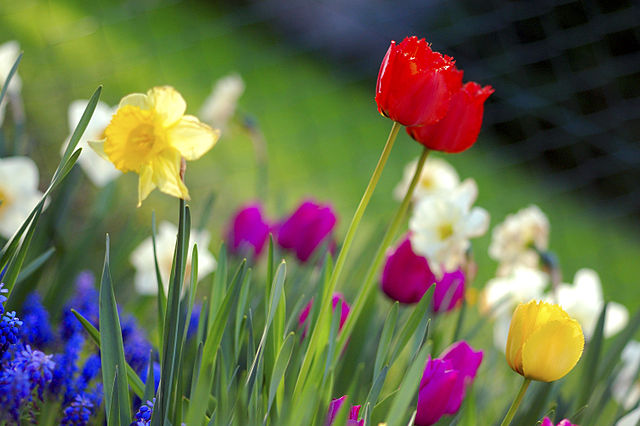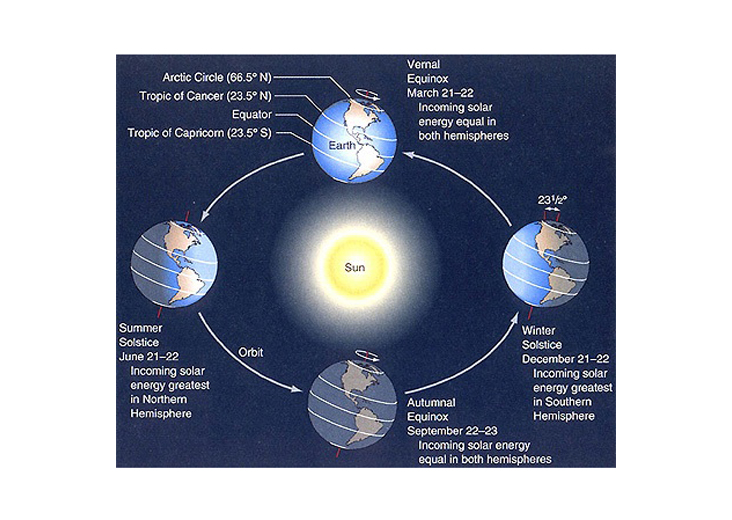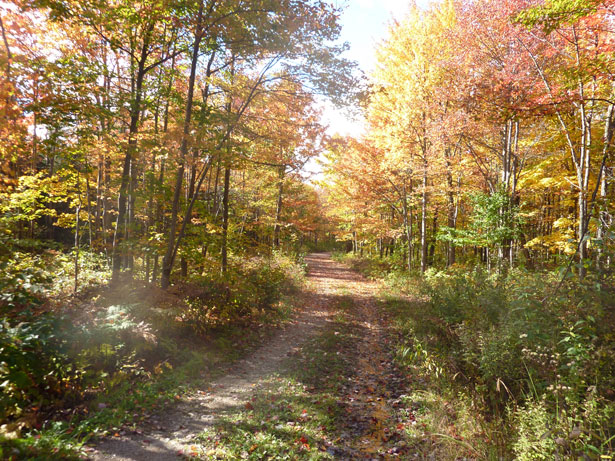

Today the March Equinox takes place ending winter and ushering in spring. To find out the exact time this will occur where you live, please go to www.timeanddate.com.

The March Equinox marks the moment where the Sun crosses the equator and usually occurs between March 19-21 every year. Both the March and September equinoxes are when the Sun shines directly on the equator making night and day nearly equal. This equinox is the transition from winter to spring in the Northern Hemisphere but the reverse in the Southern Hemisphere (summer into fall). Various cultures celebrate March equinox as a time of rebirth. Many spring festivals are timed to coincide with the equinox and some religious events (Passover and Easter) use specific calculations based on the equinox to help determine the exact day of the event.

Early spring is when the Earth’s axis increases its tilt relative to the Sun resulting in more daylight for that part world where it spring is occurring. It is a time when the increased warmth results in more plant growth (spring forth as it used to be said and how spring got its name). The resulting warmth also makes snow melt causing streams to swell and frosts to diminish. For areas that get little or no snow, ground temperatures will increase quickly as well. Despite spring beginning in March, in areas where there is no snow early plant growth can begin as early as February (or August down below). Arctic zones may not experience spring until May.
However, despite all this, winter can and does often continue on in many places. And spring also heralds unpredictable weather. There is a funny Garfield cartoon that illustrates it perfectly. Garfield is outside. First it is warm and sunny. Then cold and rainy. Then back to warm and sunny. And then rain again and then another dry day. Finally, Garfield yells in exasperation “Will you make up your mind?” The next frame is split with one half having rain and the other half sunny.
Welcome to Spring!
“Look Inside ‘Titanic’ Mansion That Went Unseen for Over 100 Years.” Liverpool Echo, 30 Dec. 2023, www.liverpoolecho.co.uk/news/liverpool-news/gallery/photos-inside-titanic-mansion-went-28318363.
These photos offer a look inside a historic mansion with links to the Titanic which went unseen by the public for 140 years. Beach Lawn House is a stunning Victorian Villa in Waterloo, that was built for Thomas Henry Ismay who founded the White Star Line. He paid £2,500 for the Grade-II listed house on December 17, 1860.
=
“New Titanic-inspired Cookbook Plays Out Against the Real — and Reel — Worlds of the Ship – Chicago Sun-Times.” Chicago Sun-Times, 26 Dec. 2023, chicago.suntimes.com/taste/2023/12/27/24012380/new-titanic-inspired-cookbook-recipes.
Hinke’s latest book, “Titanic: The Official Cookbook: 40 Timeless Recipes for Every Occasion” (Insight Editions, 144 pages), celebrates the culinary elegance and history of the ship as seen through the lens of James Cameron’s Oscar-winning film “Titanic,” which celebrated the 25th anniversary of its release in 2022.
=
“Charles Joughin: How Whiskey Saved the Head Baker of the Titanic.” History Defined -, 24 Dec. 2023, www.historydefined.net/charles-joughin.
Although the extravagance of the voyage is well known, the pastries that Joughin was responsible for creating are not why he is remembered. Instead, Joughin is best known for his remarkable survival in the face of imminent death. Historians and scientists attribute his survival to one thing: the sheer amount of alcohol he consumed that night.
=
A Massive Titanic Exhibition ‘Using Imagery and Audio’ Is Sailing Into Birmingham in 2024.” Secret Birmingham, 21 Dec. 2023, secretbirmingham.com/titanic-exhibition-birmingham.
[I guess this comes under the heading of advanced notice! This exhibition does not begin till July 2024, so I guess the promoter sent out notices to the local media. People will rush to the article thinking that this opens soon in Birmingham (UK) only to find they have many months to wait. I guess you can watch several Titanic movies and books while you wait for it to open.]
But a titanic ‘Titanic Exhibition’ will soon tell its tragic story like you’ve seen never before when it comes to Birmingham in 2024. Tracing the ocean liner’s journey from its construction at a shipyard in Belfast, through its fateful voyage, to its rediscovery at the bottom of the ocean. You’ll be able to see everything from interactive exhibits to footage of the wreckage, as well as props from the 1997 blockbuster film.
Sailing into the NEC Birmingham from Saturday, July 27 to Sunday, August 25, 2024, the exhibition will use imagery, audio and real objects from the Titanic to convey life onboard the ship. Visitors will be able to see items and read stories about the first, second and third-class passengers, plus crew and engineers. There’s even a photographic collection from onboard passenger and survivor, Father Browne.

Daylight Savings Time ended at 2am this morning. If you did not set your clock back one hour, now is the time to set your clocks back. On an old episode of Match Game, one of the panelists forgot to do this and this didn’t show up when they began taping. And it can become terribly embarrassing to admit to an employer or to a school that you forgot to reset your clocks.
The debate over changing how we set the hours in a day has been going on for a long time. In olden times, people pretty much went by the sun and its position in the sky. Then as we got more sophisticated, we developed devices that measured how time passed during the day. To help people who did not have such devices, churches or government buildings rang bells hourly. Ships had bells that chimed off the watch so the crews knew exactly what time it was. The standardization of time was encouraged by railroads and steamships that needed to have accurate schedules for trains to run. That led to international standards being developed and time zones created.
Most were fine with standard time, which simply put is when the sun comes up and goes down according to the astronomical calendar. That generally means more sunlight in spring and summer and less sun in the autumn and winter. It was during World War I that the first use of what is called Daylight Savings Time. Germany introduced to conserve fuel by extending the clock by one hour. The US introduced it as well in 1918 which had it begin in March 1918 and end in October. Once the war was over though, the law was repealed. Daylight Savings was unpopular in many areas (mostly rural). Some cities kept though (like New York City). Nationwide Daylight Savings was reintroduced in 1942 but made year-round during the war. After the war, many states adopted the use of Daylight Savings as summer Daylight Savings Time. Not all did though, which led to confusion with transportation timetables. Pressure was brought to bear on the federal government to act.
In 1966 the Uniform Time Act was enacted imposing nationally both Standard and Daylight Savings Time. Starting in 1967, clocks were advanced one hour on the last Sunday in April and fell back one hour on the last Sunday in October. States were given the option whether to change their clocks or not. Daylight Savings was once again imposed nationally during the Arab Oil Embargo between 1973-1975. It started out popular but quickly faded. My mother didn’t like it since mornings were very dark in the winter during this time. Its popularity dropped and it came to an end. In 2007 the start of Daylight Savings was changed to starting on the second Sunday in March and ending on the first Sunday in November. The downside was and still is that some areas have sunrise during Daylight Savings as late as 8:30 am.
Various states and groups have sought for the reintroduction of national Daylight Savings Time to avoid the changing of the clocks. Many cite the hassles and the fact it causes problems adjusting to changing forward and back. States passed laws in support of the change. In 2022 the U.S. Senate passed the Sunshine Protection Act to impose Daylight Savings nationally. It went to the House of Representatives but a lot of groups protested the change and it was not put to a vote so it ended up dying at the end of the legislative session. I think the simple way was the easiest. Just stay on standard time year round and do not mess with it.
Autumn is in full splendor if you live in an area where the trees change colors allowing for some breathtaking scenes. Alas if you live in an area that has lots of evergreen trees, palms, and assorted others those annual changes are not seen much accept in areas where those trees grow. Fortunately the Internet does allow us to travel and see the colors in many areas.
Have a nice Sunday everyone.

https://www.youtube.com/live/KVSZxLYkI8k?si=W5PQiJeyVrQl0Cz7

Happy Sunday everyone. Summer officially came to an end with the Autumnal Equinox back in September. Some areas, in particular in the American Northeast are seeing the fall colors in full bloom. So much so in some cases that people are traveling long distances to see them in sometimes remote locations, small towns, and often to the distress of locals their own property. A few small towns have decided to limit traffic into their areas due to the large crowds trampling about, causing delays in traffic, and since their are no toilers nearby some choose to relieve themselves in private land.
In most areas signs of Autumn and Halloween are everywhere. Houses are being decorated, pumpkins are being carved, spooky hayrides are taking places, and Haunted Houses are open. That perennial favorite-the Headless Horseman-is supposedly making appearances as well. But appearances of the next holiday season-Christmas-are also being seen. My local grocery store already has the Christmas decorations out and set up displays to merchandise for the holiday. The minute Halloween is over, those items go into the sale bin and replaced. But for the moment we can enjoy the fall even though in some places it is still hot as summer.
October Information
October is the 10th month on the Gregorian and Julian calendars. Under the old Roman calendar this was the eighth month and retained its name. October in the Northern Hemisphere begins the full transition to Autumn while in the Southern Hemisphere it is Spring.
Autumn harvests are underway this month with apples, artichokes, cranberries, pears, and pumpkins becoming widely available in many areas. Pumpkins are important this time of year as decorations and the source for pumpkin pie and delicious roasted pumpkin seeds. Oktoberfest is a major event in Munich, Germany but has spread into Europe, the United States and South America. It began in 1810 to honor a Bavarian royal wedding and now is in many places like a carnival with rides, lots of German themed food and of course beer. Beer of all kinds, especially craft beers find their ways to such events to be judged. Octoberfest usually goes from mid-September to October (it used to end on the first Sunday in October) but it usually goes on later these days. One figure estimates the consumption of beer to be around 1.85 million gallons (7 million liters) of beer. Now that is a lot of beer!
Daylight Savings Time comes to an end in Australia and Europe this month. In the United States, that will occur on the first Sunday in November. Though legislation was passed in the U.S. Senate to change to Daylight Savings Time for the entire year, the House of Representatives did not pass it due to multiple objections. So the United States will remain on using both Standard and Daylight Savings Time.
What used to be a day to prepare for the feast of All Saints Day now has morphed into an event primarily for children to put on masks and ask neighbors for a treat. Haunted House exhibits are open, hayrides through a haunted landscape, and of course scary movies to watch. We get the obligatory Halloween themed commercials and lots of scary themed promos. Many parents opt to have simpler old fashioned celebration with friends and children assembling for food, entertainment, and of course hearing very spooky stories.

(CatholicCulture.org,:Book of Blessings: Blessing of Mothers on Mother’s Day)
 Today is the March/Spring Equinox. This equinox marks the moment where the Sun crosses the equator and usually occurs between March 19-21 every year. Both the March and September equinoxes are when the Sun shines directly on the equator making night and day nearly equal.
Today is the March/Spring Equinox. This equinox marks the moment where the Sun crosses the equator and usually occurs between March 19-21 every year. Both the March and September equinoxes are when the Sun shines directly on the equator making night and day nearly equal.
The March equinox is the transition from winter to spring in the Northern Hemisphere but the reverse in the Southern Hemisphere (summer into fall). Various cultures celebrate March equinox as a time of rebirth. Many spring festivals are timed to coincide with the equinox and some religious events (Passover and Easter) use specific calculations based on the equinox to help determine the exact day of the event.
Though the equinox marks the changing of the seasons, it is quite common for winter effects to continue in many places far until May or even June.
And if you live in an agricultural area where sheep abound, a sure sign of Spring is that lambs are born. Lots of them. To this day no scientist has ever figured how the mother can instantly know her offspring in a field where so many lambs abound.
